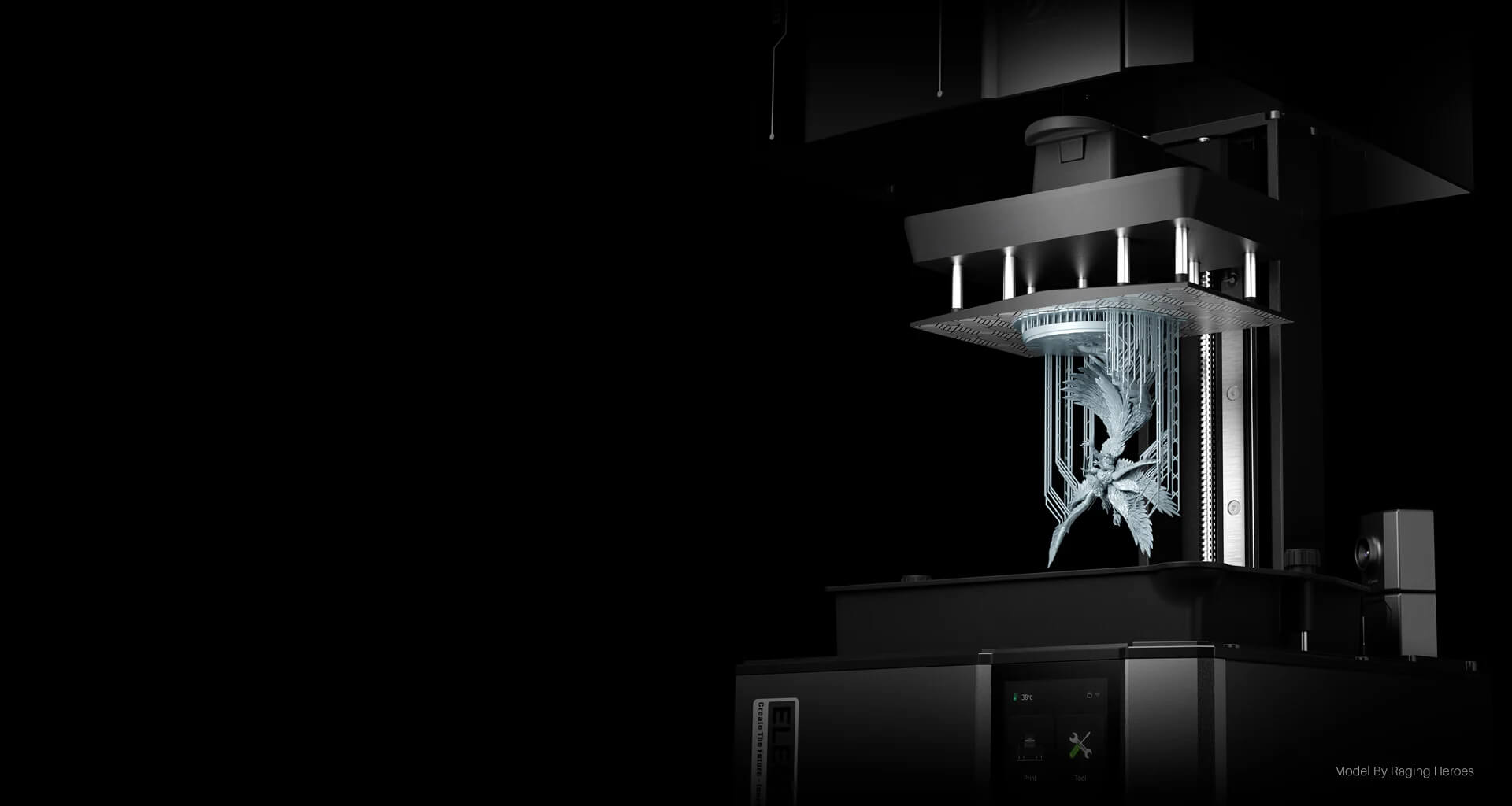Hands-On Review
Elegoo Mars 5 Ultra Review
Elegoo has released the latest addition to their ever popular Mars line of resin 3D printers, in the form of the Mars 5 Ultra. Boasting a 9K mono LED screen, smart sensors, an “AI camera”, and an attractive exterior, the Mars 5 Ultra is aimed at beginners with its affordable price point.
In this review, we will be taking a look at the Elegoo Mars 5 Ultra, and seeing if it’s more than simply a beginner friendly resin printer.
Out of the Box
Unpacking the Elegoo Mars 5 Ultra doesn’t take long, and aside from the build plate and drip tray, it requires no assembly at all. The box contains the printer, lid, drip tray, Wi-fi antenna, and power supply. A small tool kit is included, containing gloves, masks, a scraper, a USB stick, some spare screws and a couple of hand tools.

The machine itself only weighs 8.8kg, so lifting it onto a shelf for usage isn’t strenuous, and the unit itself measures 260 x 268 x 451.5 mm, so it won’t take up a lot of space. Note, that the lid is not hinged though, so you will need a bit of clearance above it when removing the lid to fill the tank or retrieve your finished prints.
In terms of specifications, the Mars 5 Ultra features a 4.0-inch capacitive touch screen, 7-inch 9K mono LCD, and 153.36 x 77.76 x 165 mm³ build volume.
On the performance side, the Mars 5 Ultra can print at a maximum speed of 150mm/h, with layer thicknesses ranging between 0.01-0.2mm, an XY resolution of 18×18μm, and a Z-axis accuracy of 0.02mm.

Without even printing anything, we can assume from those specs that the Mars 5 Ultra should be capable of creating some detailed and smooth prints, especially thanks to its impressive XY resolution.
One more thing to mention, is that the Elegoo Mars 5 Ultra also comes with a free one year subscription to Chitubox Pro, which is nice, considering the regular subscription price is $169
per year – that’s only $100 less than the price of the Mars 5 Ultra itself (which is currently on sale at $269.99)!
Setting Up
Setting up the Mars 5 Ultra was easy enough. Simply unpack it, set it down somewhere sturdy and flat, plug it in, and follow the on-screen setup guide. This will guide you through connecting to WiFi ready for your first print.

To test the Elegoo Mars 5 Ultra, we used two different resins. I opted for the Elegoo ABS-like 2.0 (in grey) resin, because I have used this before and I can confirm that it’s a pretty decent resin for making tougher prints. And secondly, I opted for an eSun water washable resin (in blue), primarily because I have never used a water washable resin before, and I’m curious how good (or bad) it is.
Cleaning with IPA is a messy task (and it costs money), so anything I can do to reduce that is welcomed. I run my own prototyping business in my day-to-day existence, so I am always looking for ways to minimize costs and reduce time spent on these things – let’s see if water washables deliver on that front.
Can I Offer you Some…Copper?
For the first test print with the water washable resin, I thought it would be worthwhile to test Elegoo’s new resin slicer software (Elegoo SatelLite). We all know what ChituBox looks like at this point, and it’s always interesting to see a new slicer.
Plus, I figured the SatelLite would already have the settings for the Mars 5 Ultra, which would save on a lot of messing around if ChituBox didn’t have the machine presets already.
Well, the good news is that the Elegoo slicer did indeed have the Mars 5 Ultra profile. The bad news is that the “Device” tab is still in development (and will be functional in Q2 of this year), so I couldn’t use the WiFi, camera, or remote monitoring from this slicer.
But slicing was fine, and manual support placement was pretty good. I opted for manual placement because the object I chose to print has a lot of detail that would potentially get ruined by overzealous auto-support generation. The object in question:
A 3D scan of the “Complaint letter to Ea-Nasir”, from The British Museum.

For those unfamiliar with the story (or the meme) surrounding the clay artifact, it holds the Guinness World Record as the first complaint letter in history. It was written in cuneiform in Sumeria, circa 1750 BCE.
The gist of the complaint is that the customer (“Nanni”) is unhappy with a dodgy copper merchant (“Ea-Nasir”), for selling inferior copper ingots. The hilarious tirade details how Nanni sent his assistant to resolve the issue, and the assistant was treated rudely by the merchant. The merchant returned home without a refund and was forced to carry the substandard ingots back “through no-man’s land”.
Apparently archaeologists found many such complaint letters in the basement of Ea-Nasir’s house during excavations. By all accounts, he seemed to be a bit of a fraud.
Anyway, I thought it would be fun to have my very own Sumerian complaint letter, so I printed it on the Mars 5 Ultra. It took about 6 hours to print in total, and you can see the result below. Not bad! I’m a little sad that I couldn’t make a timelapse from it, but I attempted this on the next print, using the Elegoo resin and ChituBox.

Printing in ChituBox
I downloaded ChituBox for this second print, which, keeping with the theme of Babylonian memes, is the “Standing Male Worshipper” statue, excavated from Tell Asmar (modern day Iraq). This figure attained meme status as a proxy for the aforementioned copper merchant, despite being separated by about 1,000 years and around 1,000 km in distance from Sumeria.
The internet does not care for such details. It is now regarded by the internet as the face of Ea-Nasir.

Setting up in ChituBox is easy, as it already has the settings for the Elegoo Mars 5 Ultra available from the machine selection screen. In order to use the camera, you need to install ChituManager, which is easy enough and can be done within ChituBox itself.
According to an Elegoo rep on social media, ChituBox is the only way to use the camera at the moment, although support for Lychee is coming soon.
It has been a while since I used ChituBox, and it seems that ChituBox 2 is quite buggy. But still, it connects to the Elegoo Mars 5 Ultra without issue, and it has the Resin Alliance database included, so downloading the settings for the Elegoo ABS-like resin was easy enough.
From ChituBox I was able to orient, slice, and send the model directly to the printer over WiFi, and start the print. The time lapse can be initiated through ChituManager, although results may vary, given that the camera is only 720p, and doesn’t have a light. So if you are printing at night time, the recording quality may be a little potato-like, as you can see below.
The print took only a couple of hours, as I had it set to fast mode, which reduces the travel distance for the FEP to release (apparently).
Overall, the print quality seemed reasonable, and getting the support material off the printed model seemed easier than with other printers. I have used Elegoo ABS-like before, and I remember the marks left by the support were quite noticeable last time, but on this machine the dimples were minimum.

Final Thoughts on the Mars 5 Ultra
This was my first time using an Elegoo resin printer, and given the price, print quality, and usability, I can understand why they are popular. Both prints were successful on the first attempt, which is not always the case when reviewing resin printers. Even the water washable resin printed fine, and I had read some comments online that other users have had some issues with this type of resin.

Regarding the “AI camera”, it is hard to know how effective this is, because both of my prints came out fine. It would be nice if the camera was a higher resolution (or had a light), because the timelapse videos are a little grainy. But the machine costs $269.99 at the moment, so at this price point, it is probably a little much to expect a 4K camera fitted as standard.
It would be great if Elegoo could get their own SatelLite slicer working fully too, but as mentioned previously, the device manager function is expected to be operational in Q2 of this year.
Aside from those small items, it seems to be a fairly capable machine for a very affordable price, and it is more than suitable for beginners, and more experienced makers alike.
So if you would like to learn more about the Elegoo Mars 5 Ultra, or order one for yourself, then head on over to the Elegoo website for more information.



